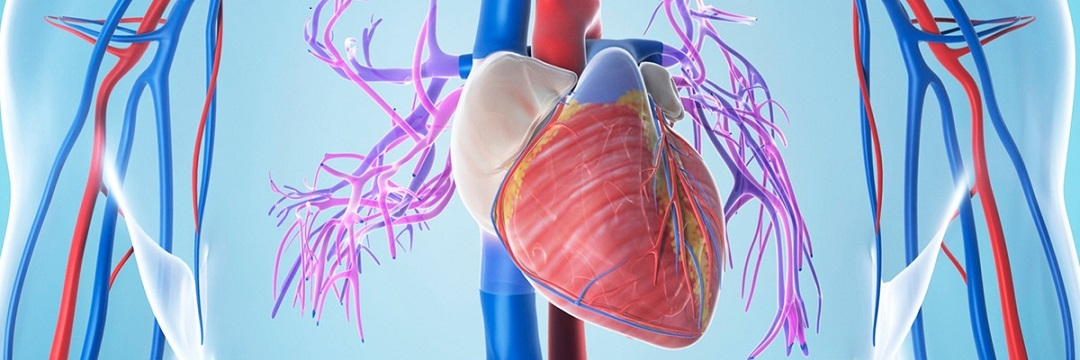
Cardiac catheterisation is an invasive procedure that makes it possible to assess the heart function from the inside.
Indications
Depending on examination aim, the catheter is inserted into the left or right compartment of the heart.
To examine the left compartment, the cannula is inserted into an artery (femoral or brachial) with the purpose:
- to measure of the pressure in the left side of the heart;
- to examine the aortal and mitral valves;
- to study blood flow parameters;
- to examine the septum and cavity of the left ventricle.
To study the right side, a catheter is inserted into a vein (femoral or ulnar), in order:
- to determine pulmonary artery pressure, pulmonary valve status;
- to evaluate the function of the right atrium and ventricle.
General indications for cardiac catheterization are:
- low informative value of other non-invasive tests;
- preparation for heart or lung transplantation;
- need to evaluate the effectiveness of previous surgical interventions;
- need to detect congenital and acquired defects and anomalies of coronary vessels and heart;
- necessity to determine the severity of ischemia in CHD;
- need to measure pulmonary hypertension.
Contraindications for a catheter procedure
All contraindications for cardiac catheterization are either temporary or relative. These include:
- Acute myocardial infarction.
- Acute renal failure.
- Electrolyte imbalance.
- High levels of cardiac glycosides in the blood.
- Gastrointestinal bleeding.
Caution is advised in children under 1 year of age and patients over 70 years of age if there are underlying medical conditions:
- Cerebral circulatory disorders.
- Congenital diabetes mellitus.
- Pulmonary and renal insufficiency.
Additional examinations are recommended prior to considering catheterization in children.
The course of the procedure
The heart catheter procedure is performed under X-ray and ECG monitoring. The patient is laid on the back, given local anesthesia and sedated. General anesthesia is needed only in a very few cases. An incision is made in the skin at the insertion point of the radiopaque tube, through which the catheter is inserted into the vascular cavity, and led towards the heart. Its movement is monitored by an X-ray device. During the examination, a contrast agent is injected to visualize the vessels and heart cavities. A series of images are taken.
In course of the entire procedure, vital signs (heart rate, respiration rate and blood pressure) are kept under control.
The patient will not feel any pain during the procedure, but may feel discomfort and nausea, and will be asked to cough to reduce this.
Second opinion proves: heart catheter is not always necessary
Heart catheters are very frequently used in German hospitals for the diagnosis and treatment of cardiovascular diseases. However, almost half of these interventions are not performed on an emergency basis, but to identify the cause of cardiac complaints. Still, there are alternative methods that are non-invasive, i.e., do not require penetration into the body, and therefore have lower complication risks. To prevent unnecessary exams, the German Institute for Quality and Efficiency in Health Care (IQWiG) proposes to legislate a right to a second opinion for the following elective procedures:
- implantation of defibrillators and pacemakers;
- electrophysiological study with ablation;
- myocardial perfusion imaging;
- percutaneous coronary intervention;
- cardiac catheter study/coronary angiography;
- surgery for (intact) aortic aneurysms;
- heart valve replacement and aortocoronary bypass surgery.
If a heart attack is suspected a catheter is the only method
A catheter (thin tube) is inserted into a vessel through a small incision and moved from the groin or wrist to the heart. It can be used to detect narrowings in the coronary arteries and, if necessary, treat them with a stent. In Germany this procedure is performed more than a million times a year - approximately twice as often as in countries with comparable levels of health care.
In emergency situations when a heart attack may occur, invasive catheter examinations have no alternative and can be life-saving: if a patient complains of chest pain or breathlessness, or if there are certain risk factors, the heart should probably be treated immediately with a catheter.
Not all heart exams are appropriate
A second opinion may suggest alternative ways
If patients have doubts, healthcare professionals should encourage them to get a second opinion. It is important that patients feel confident before surgery, feel that they are well looked after, and understand why, when and what needs to happen. However, many patients hesitate to ask for a second opinion for fear of offending the attending physician. Therefore, a trusting relationship between patients and treating physicians is very important. It is also important to discuss all issues in detail in order to make a joint decision for or against the intervention.


Comments — 11
Ольга
Уважаемая Марина,приналичии кисты перикарда в каких случаях необходима Linkskateteruntersuchung? Или возможно обойтись MRt?
Marina Virko
Уважаемая Ольга! При наличии кисты перикарда обычно проводится ЭХО-КГ, КТ и МРТ. Если показано оперативное вмешательство, удаление кисты проводится в рамках торакоскопии, реже обычным хирургическим вмешательством. Что касается катетеризации, возможно есть отдельные обстоятельства, требующие проведения данного исследования. В случае Вашей заинтересованности можем предложить проведение заочной консультации. С уважением, Марина Вирко
Александр
Здравствуйте. У меня незначительные загрудинные боли. Мне сделали сцинтиграфию. Вот результат: Befund: Die Belastungs- und Ruheaufnahmen zeigen eine reversible Perfusionsstörung posterolateral, weitgehend unauffällige Nuklidbelegung des übrigen linksventrikulären Myokards. Die EF nach Belastung beträgt: > 65 %, die nach der Ruheinjektion beträgt: > 65 %. Beurteilung: Belastungsinduzierte Ischämie posterolateral, ca. 10 %. Keine Myokardnarben. По результатам кардиолог направил на катетеризацию с диагнозом "KHK". Из-за недостаточного немецкого я не понял, для чего. Какая в этом необходимость при незначительных болях и какие риски в мои 80 лет? Спасибо.
Команда MedConsOnline
Добрый день! В заключении упоминается нарушение перфузии (то есть кровоснабжения) миокарда, это может быть показанием к проведению катетерного исследования. Но если Вы сомневаетесь в ее целесообразности, можем рекомендовать обратиться за вторым мнением к нашим консультантам по ишемической болезни сердца https://medconsonline.com/ru/zabolevanija/kardiologiya/ishemitsheskaya-bolezn-serdtsa Если нужна будет помощь в заказе консультации, мы окажем всю необходимую поддержку. С уважением, Команда MedconsOnline
Иван
Не понимаю, как можно утверждать, что катетерное исследование сердца у новорожденных так же безопасно, как и у взрослых. У грудничков все такое крошечное! В то же время мое сердце разрывается на части при мысли о том, что я не сделаю для своего ребенка, все что сегодня может предложить медицина.
Marina Virko
Здравствуйте. Такие сложные вмешательства в Германии детям проводят только в специализированных, современно оборудованных центрах. Детские кардиологи работают вместе с детскими анестезиологами, наблюдающими детей в течение всей процедуры. Сердечный катетер позволяет не только подготовить младенцев к зачастую неизбежной операции, но и провести, например, электрофизиологическое вмешательство, т.е устранить врожденное нарушение сердечного ритма. А это закладывает фундамент здоровья ребенка на всю жизнь.
Игорь
Здравствуйте. У меня порок митрального клапана, врач настоятельно советует оперироваться. Никак не могу решиться. Прочитал, что за рубежом перед такой операций проводят катетерную эхокардиографию. Могли бы Вы объяснить, в чем ее преимущества?
Marina Virko
Эхокардиография, проводимая во время катетерной интервенции сердца позволяет визуализировать структуры, которые не различимы или очень плохо видны в рентгеновской диагностике, в том числе в компьютерной томографии. Инновационный метод позволяет с высокой точностью определить анатомию сердца и, соответственно, принять решение, показано ли то или иное вмешательство на сердце конкретному пациенту. Современные поддержанные катетером методы лечения структурных заболеваний сердца невозможны без интервенционной эхокардиографии как для управления процессом операции, так и для успешного контроля её результатов на работающем сердце.
Игорь
У меня время от времени бывает очень сильное сердцебиение. Не могу сказать, что это связано со стрессом или с какими-то другими причинами. Повлиять на него никак не могу. Раньше просто проходило, а сейчас чувствую себя усталой, не могу толком работать. Это опасно?
Marina Virko
Ухудшение Вашего состояния может свидетельствовать о прогрессе заболевания, нарушение сердечного ритма действительно может представлять собой серьёзную угрозу здоровью. Вам обязательно нужно обратиться за консультацией к кардиологу и пройти диагностику, чтобы определить, какой именно вид нарушения ритма Вас беспокоит и есть ли у Вас возможно серьёзное заболевание сердца, которое привело к новым жалобам. Затем может быть назначена терапия. При наличии результатов обследования целесообразно обратиться за получением второго мнения. Это можно сделать даже заочно, письменно или по видеосвязи с кардиологом в Германии.
Dan
Хорошая статья